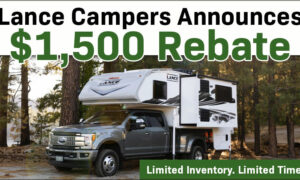Ascending the cliff face of mainstream life often means letting go of your dreams. Scott and Johanna Cameron dared to challenge this path, assemble a truck camper rig, and climb in a very different direction. Rock Resolution, and roll.

What would you give up to save money? Would you cut cable television? Downgrade your cell phone and wireless plan? Turn down the air conditioning or heat in your home? Stop going out to eat? Sell your car and only use public transportation?
Cut up your credit cards? Sell everything you don’t use or need? Lower your water heater? Cancel your gym or club memberships? Cancel your paid newspaper and magazine subscriptions? Only buy generics? Stop drinking and other expensive habits? Move to a cheaper area?
No way, right?
But what if doing these things – perhaps all of these things and more – meant you could live your dreams – not tomorrow or someday, but right now.
Would giving up cable television be so hard if you could have the life you truly want? Would downgrading your cell phone plan be such a burden if your everyday life was full of what you love to do the most?
It’s not an easy question as most of us are addicted to these luxuries. We can’t imagine life without going out to eat regularly. We start to get sick just thinking about selling almost everything we own. Give up beer and wine? Forget about it.
Scott and Johanna Cameron have a different take on this question. Not too long ago they were project managers longing to live a life of freedom, rock climbing, and traveling. Without kids, pets or a mortgage, it dawned on them that the freewheeling, climbing, and traveling lifestyle of their dreams was simply a decision.
What follows is their story after making the leap. Hold that break line, and don’t look down.
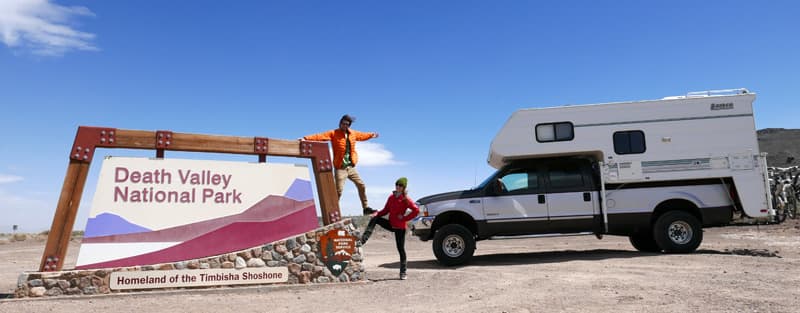
TCM: You guys come from very different backgrounds on two separate continents. Tell us about how you both got into camping.
Scott: I grew up in the Sierra Nevada Mountains near Yosemite, so I went camping a lot as a kid. My parents still have the original truck camper that I grew up camping in; a 1985 Lance 825 on a 1989 Ford F250. I guess it was natural that I would one day follow in the footsteps of my father.
Johanna: I did not grow up camping in France, but always had the desire to go camping. Pickup trucks are rare in France, so truck campers are even more rare.
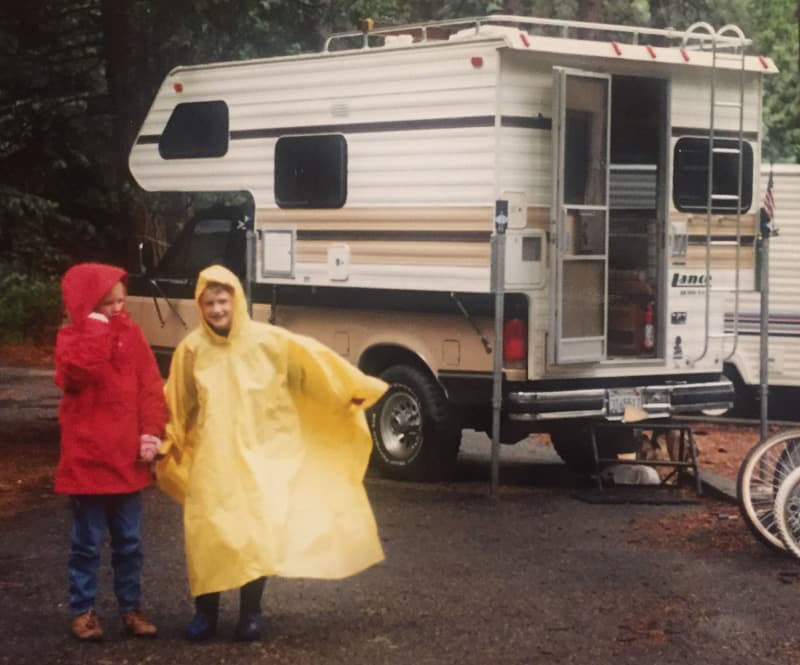
Above: Scott’s family had a 1985 Lance 825 on a 1989 Ford F250 when he was growing up
TCM: Did you naturally gravitate to a truck camper after having camped in one as a kid?
Scott: Actually, we initially looked into van conversions, but one of our main requirements was four-wheel drive. Four-wheel drive vans are both hard to come-by, and expensive, in the realm of vans.
My parents offered us their Lance Camper. All we needed was a burly truck. After countless hours of research on used trucks and engines, we opted for a Ford 7.3L Powerstroke diesel. The 7.3L is said to be one of the most reliable and efficient diesel truck engines to date.
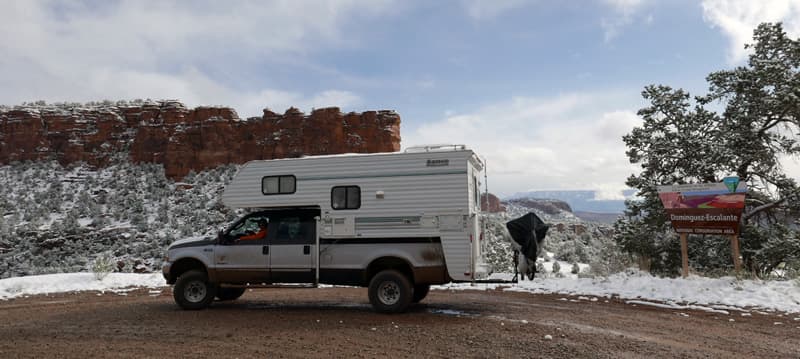
Above: Their Ford F350, aka Big Pipe, and Lance 915 in Unaweep Canyon, Colorado
We needed an eight-foot bed, and desired the full-length crew cab for extra space; which we found in a 2003 Ford F350 we now affectionately call, Big Pipe.
Where this story takes a turn is when we discovered – the hard way – that the vintage camper did not fit the newer Ford bed styles. After a moment of panic we ended up getting really lucky in finding our mint condition 2000 Lance Lite 915, which fits absolutely perfect with our truck.
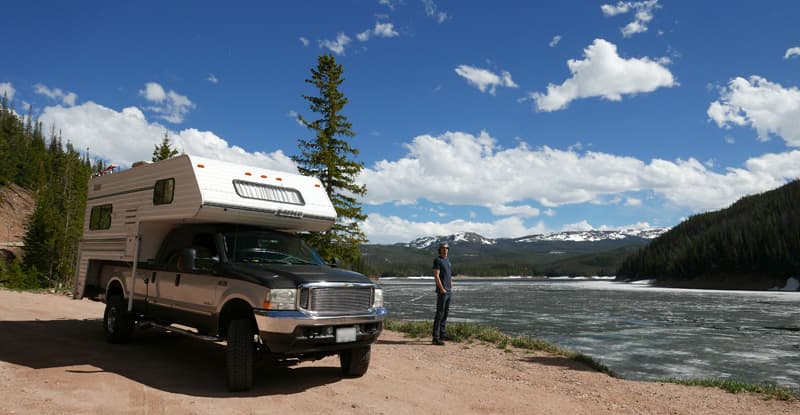
Above: Chambers Lake, Poudre Canyon, Colorado
TCM: The problem of new truck beds not fitting older campers continues to this day. The 2017 Ford Super Duty truck beds have fit incompatibilities with a number of older campers. What modifications have you made to your rig?
Scott: We built a lock box to store valuables such as passports and laptops. We also built a center console in the truck out of wood we had lying around to keep things organized. Last, but possibly most important, is the electrical upgrades with a killer sound system, backup camera, and alarm.
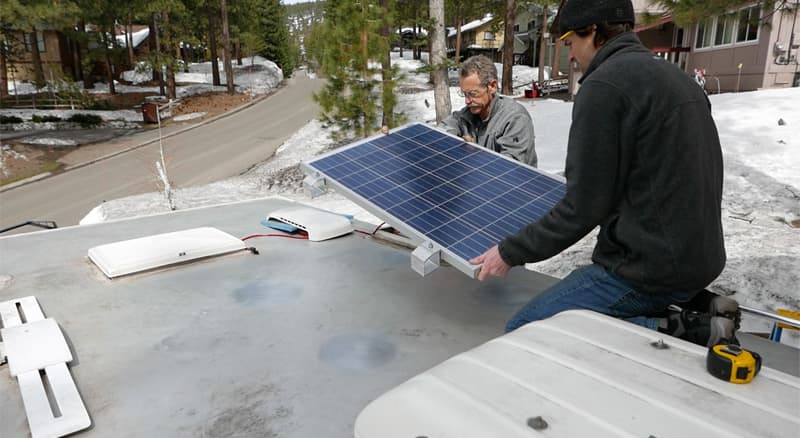
On the camper we installed a solar panel and power inverter. That included fabricating custom mounts for the panel out of some aluminum scrap metal found on the roadside.
Inside the camper we installed a few additional shelves/racks for clothing organization. We also built a custom spice rack out of recycled beautiful straight-grain redwood.
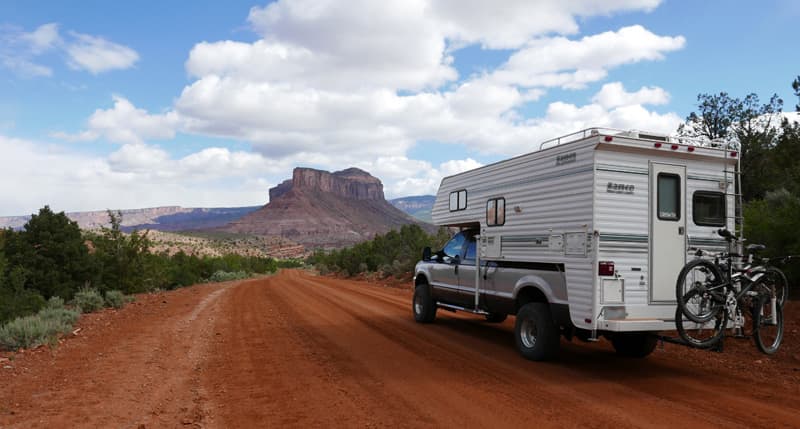
Above: Their bike rack has a hitch extension with a step
To mount our bike rack we built a hitch extension with a step. It allows the bikes to stay racked without interfering with the camper’s door, providing easy access with no hassle.
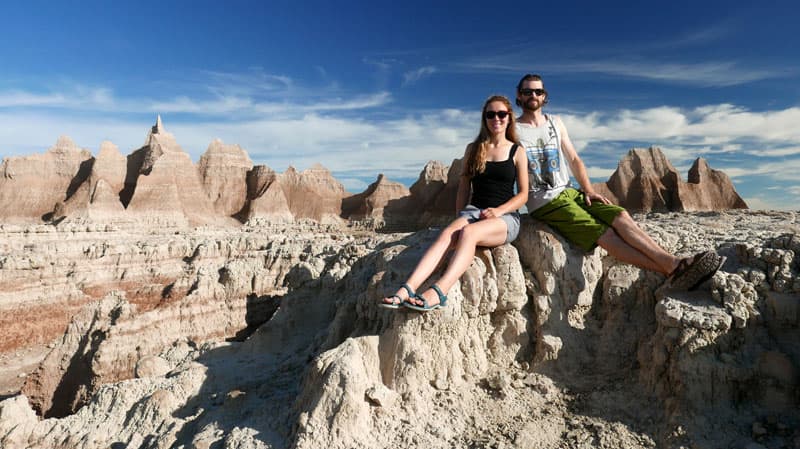
Above: Johanna and Scott in Badlands National Park, South Dakota
TCM: The roadside aluminum scrap was a lucky find. How and when did you decide to go full-time in your truck camper?
Scott: There was never really one specific day that we said, “Let’s go full-time”. It was an evolution that started with the realization that we don’t have to work full-time to survive and that we could quit our jobs. Then you start thinking of the possibilities.
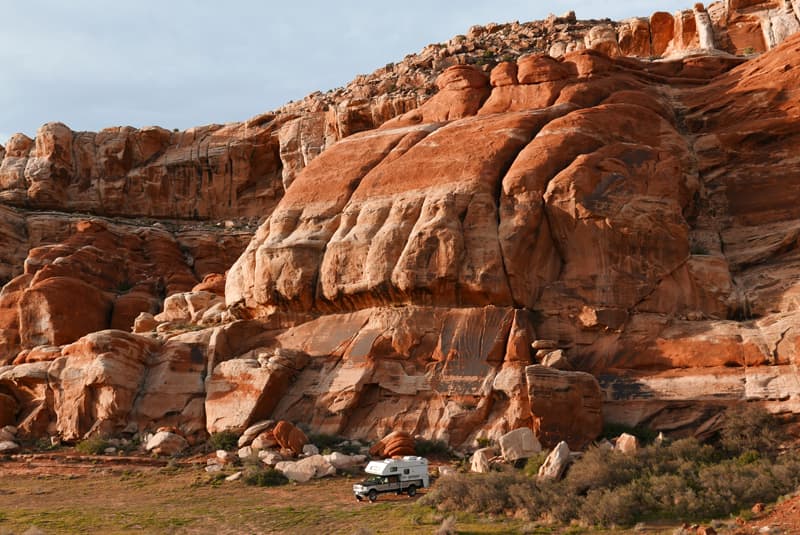
Above: Camping near Moab, Utah
Johanna: We want to travel and were influenced by people full-timing on Instagram and on the internet. At first we thought we’d do a big trip around the world. We started to save money and committed to buying a truck. That made it all happen.
There was nothing forcing us to have a typical lifestyle. We did not have a house or pets or kids, and we wanted to see the country. It takes awhile to really travel. We needed a long time to do what we wanted to do.
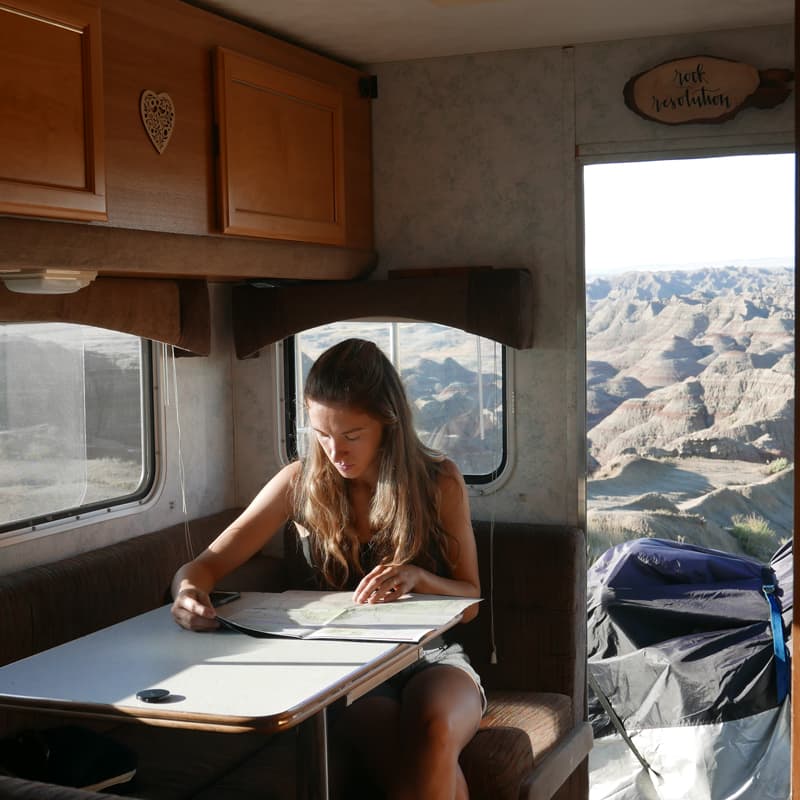
Above: Reading a map in Badlands National Park, South Dakota
Scott: We always went on weekend trips from work, but could only get so far. We couldn’t get to the places we wanted to go with only a few weeks of vacation a year. We couldn’t live an adventurous lifestyle that way. We wanted more, and nothing was stopping us from doing it.
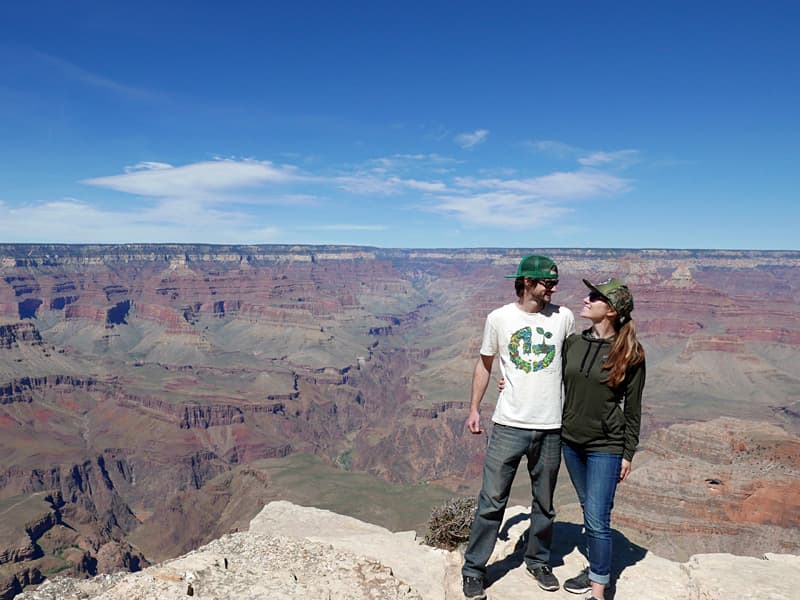
Above: Scott and Johanna at the Grand Canyon, Arizona
TCM: You are both quite young. How are you affording this full-time traveling lifestyle without an income?
Johanna: We are very good at saving money because we don’t spend too much. The general idea in the western world is to spend money on a new car, a house, and having a family. Those things don’t appeal to us as much as other people.
Our co-workers who had the same income were surprised at how much we saved. I think anyone can do it, but it’s being able to refrain yourself from spending too much while working. Right now we don’t have income, but we’ll probably go back to work at some point. We have a small storage unit with all our stuff.
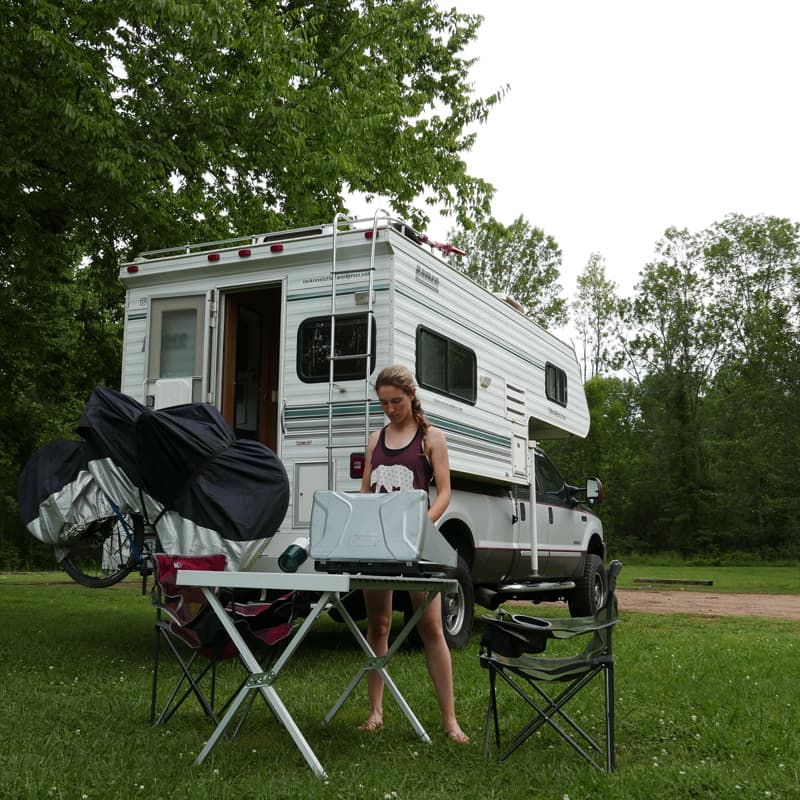
Above: Boondocking in Chattanooga, Tennessee
Scott: Once we started saving, we had the mindset of keeping track of finances and how much we would need to live full-time on the road. We saved money fast. Actually, we thought we would have to work longer. We quit our jobs about a year before we thought we were going to be able to do it. Why wait?
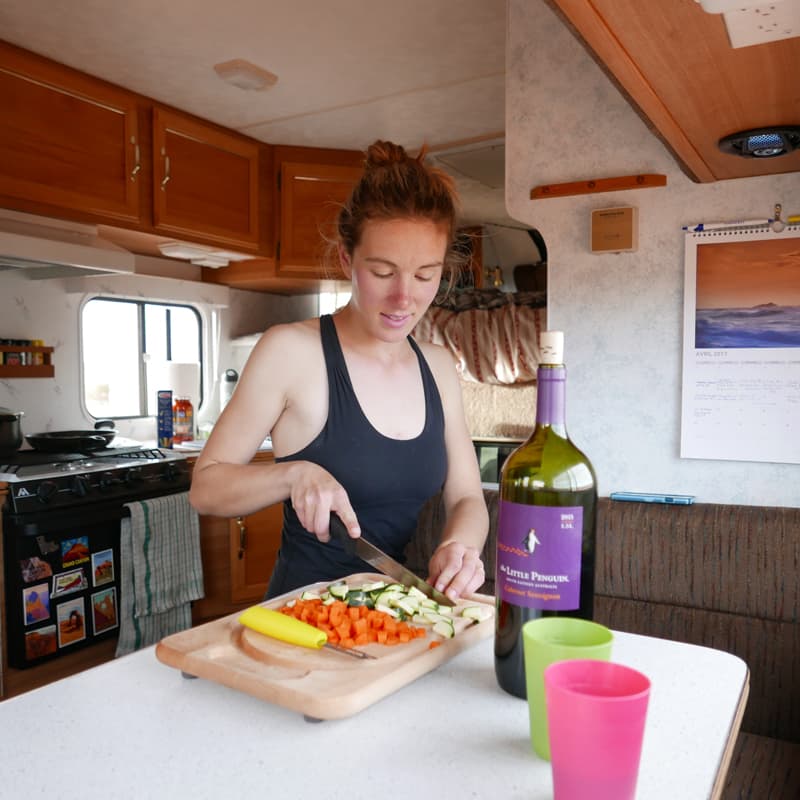
TCM: Time is the ultimate commodity. What kinds of things did you cut back on or change to save money?
Scott: Something a lot people won’t agree with is that we cut back on alcohol. Just doing that resulted in significant money savings.
We have to spend money on fuel and food but, in grocery stores, if it’s not on sale we usually don’t get it. We try to stay focused on purchases that provide nutritional benefit to what we are doing, and cut out junk. We do buy organic food whenever possible because that’s important to our active lifestyle.
Johanna: We might buy a bottle of wine once in while. Another thing is that we don’t eat out as much as when we were working. We were project managers, so we are good at keeping track of finances.
Scott: Never do we stay at paid campsites or have hookups. It has been very easy to live this way, and has saved us a substantial amount of money.
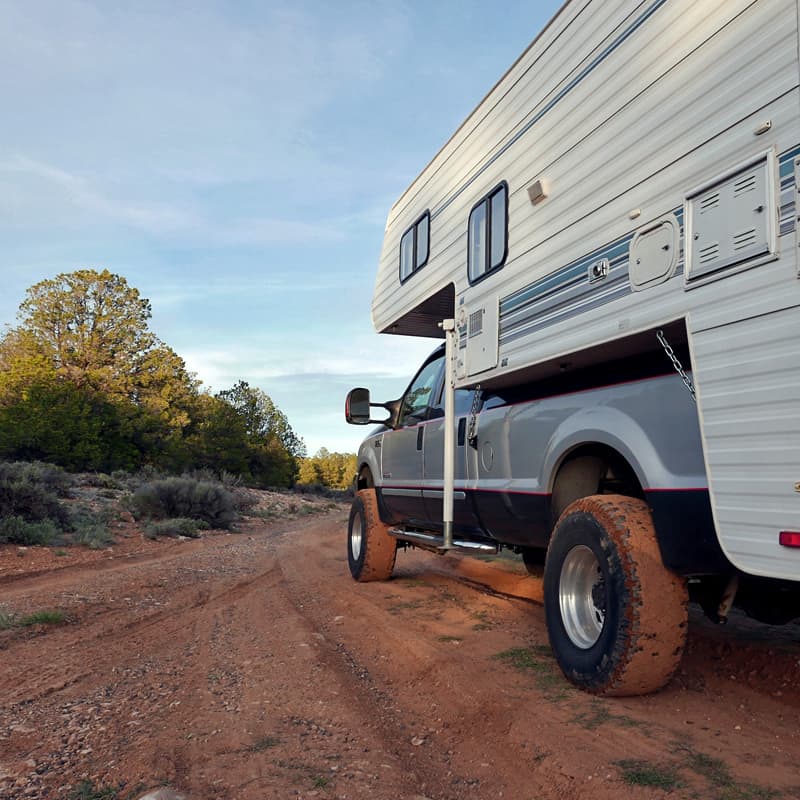
Above: Kaibab National Forest, Grand Canyon, Arizona
TCM: I understand boondocking and avoiding campgrounds, but how do you never stay in a campground? Sometimes there doesn’t seem to be another choice.
Johanna: It’s not a challenge for us. We have stayed in Walmarts. We have stayed in places that we are probably not allowed, but we have never been woken up and told that we couldn’t sleep there. We look ahead to see if we are going to be around national forest, and camp there whenever possible.
On the east coast, we stayed in more Walmarts or supermarket parking lots. It’s rare for us to stay more than a night or two somewhere. We stay out in the country more. When we visited Washington DC, we stayed at a friend’s house.
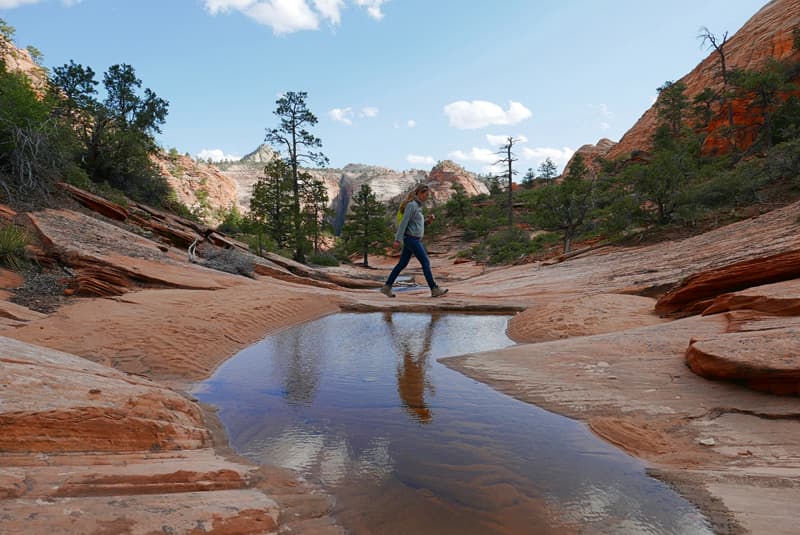
Above: Hiking in Zion National Park, Utah
TCM: It’s been quite a hot summer. As full-timers who only dry camp, how do you handle heat on the road?
Scott: The heat is definitely a thing. We have an air conditioner but it obviously can’t be plugged in when we’re dry camping. We work around the heat a lot. We find city parks and places to hang out by a creek if we’re not climbing.
Johanna: It gets cooler at night in the higher elevations. It did get really hot and humid in Tennessee, Virginia, and Maryland.
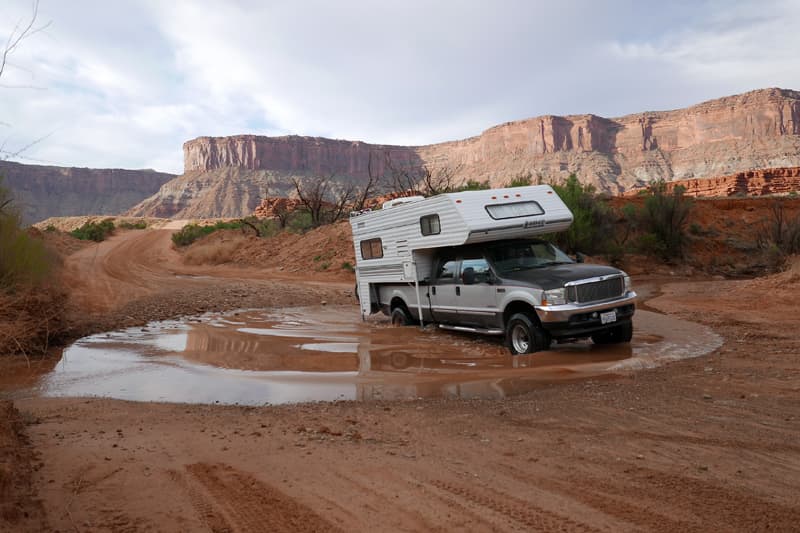
Above: Driving a dirt road in Moab, Utah
Scott: As a full-timer, that’s a lifestyle change you have to accept. You don’t have the luxuries you have in a house, but it’s survivable.
I built an evaporative cooler from simple materials that I got from the hardware store. It runs off 12-volt power and we use it if it gets too hot.
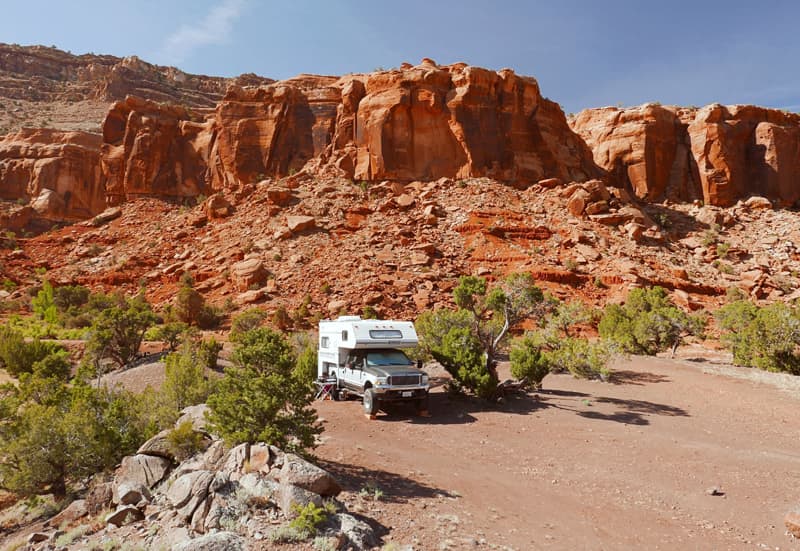
Above: Boondocking in Escalante Canyon, Colorado
TCM: Since you’re dry camping all the time, what power sources do you have on the Lance Camper?
Scott: All we have is a 100-watt panel on the roof. We have the light version of the Lance Camper, so we do not have a generator and we only have a single battery. We have one propane tank for the refrigerator and water heater.
The truck is hooked up to the camper’s battery for charging when the engine is running, and the solar charges the battery. We have a 12-volt to 110-volt inverter which charges the laptops, cell phones, cameras, and runs our blender for protein smoothies. We’ve never come close to running out of power.
One unique feature we have to conserve power are solar lights. They sit on the dash of the truck and charge while we’re driving. With these lights, we don’t have to use our camper’s lights at night.
Johanna: We typically drive every day to go to our climbing locations. That, along with the sunny weather charging the solar panel, keeps everything charged.
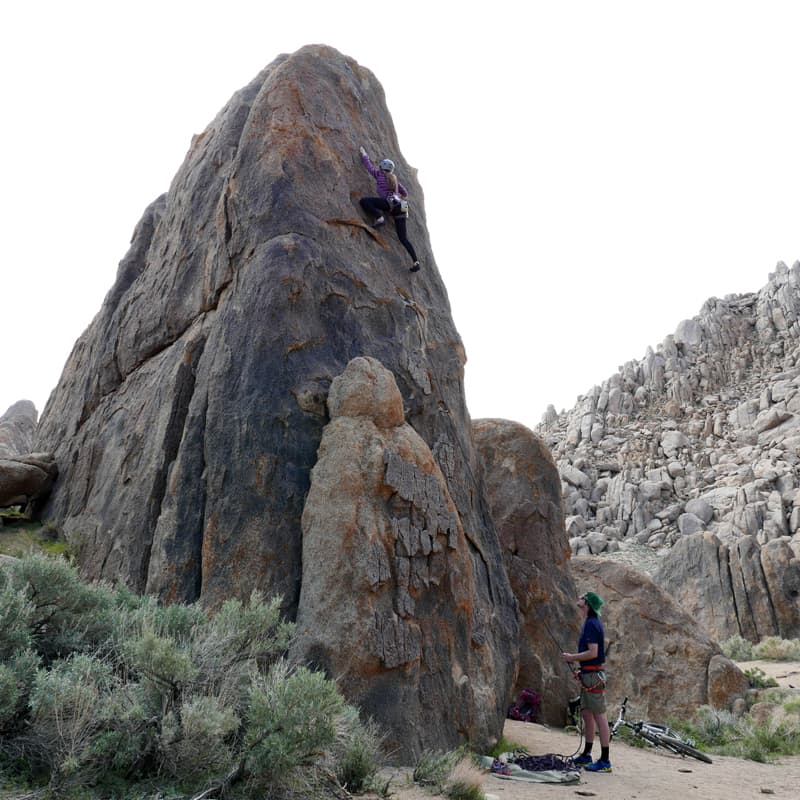
Above: Alabama Hills, California rock climbing
TCM: Solar lights are a neat idea. You mentioned your rock climbing. Is that the focus of your truck camping adventures?
Scott: Yes, rock climbing is the main focus of our travel. It just so happens that most rock climbing areas are located in spectacular settings, which works out well for our other hobbies on the road such as hiking, exploring National Parks, mountain biking, and slacklining.
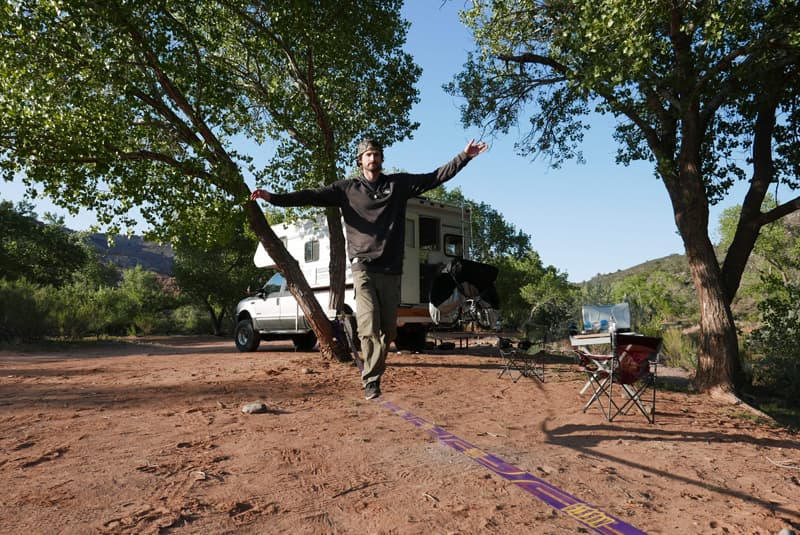
Above: Slacklining near Zion National Park
TCM: What is slacklining?
Scott: It’s popular in the climbing community. It’s tight rope walking on a loose strap. You anchor a strap between two trees. It’s a lot like a trampoline and you walk across it. A lot of people do tricks on it, which is impressive because it’s difficult.
People will set it up between two mountain peaks and walk across. It’s a good pastime for us at campsites or city parks.
It’s also good training and it’s a good ab and leg workout. It’s all about focus and balance. It uses all the muscles in your body while staying focused and relaxed, which is why climbers like it.
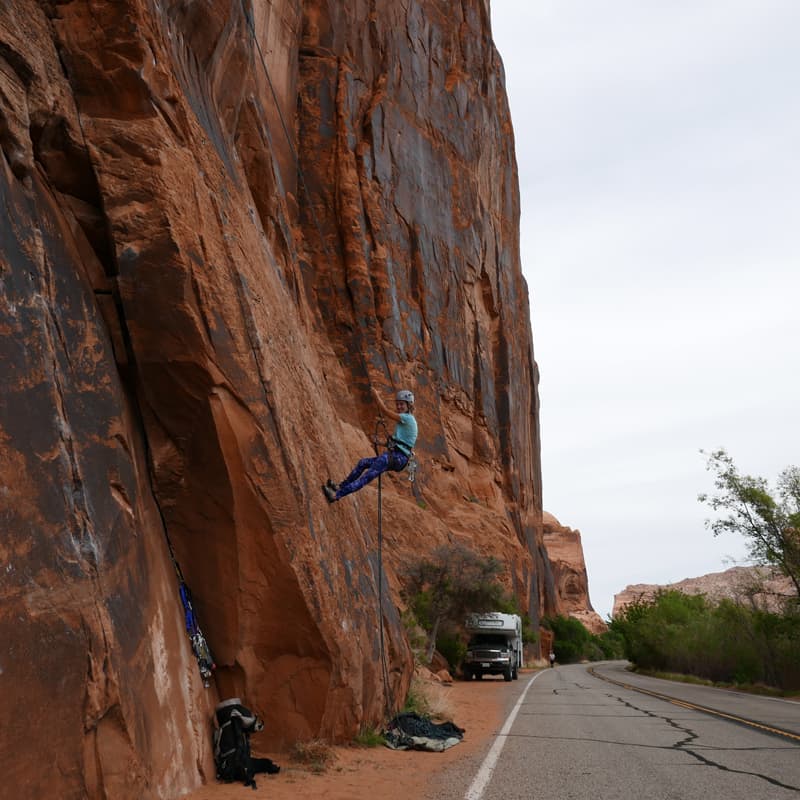
Above: Climbing in Moab, Utah
TCM: I think we saw slacklining in the movie about Philippe Petit’s 1974 high wire walk between the Twin Towers – The Walk. How did you get into rock climbing?
Scott: I got hooked on climbing through my university, but did not really fully follow it to my potential because of school and work taking up so much time. I couldn’t really make the commitment.
Before we knew each other, Johanna was living in San Francisco and she climbed at the gym and really liked it. So, when we met, it was a shared interest.
Johanna: We were together and wanted to be outdoors, so the interest grew. Scott took me outdoor climbing for the first time. He had more skills and taught me a lot.
Scott: I wanted to be a dirtbag climber. Once I found someone to do it with, it was easier to make the leap.
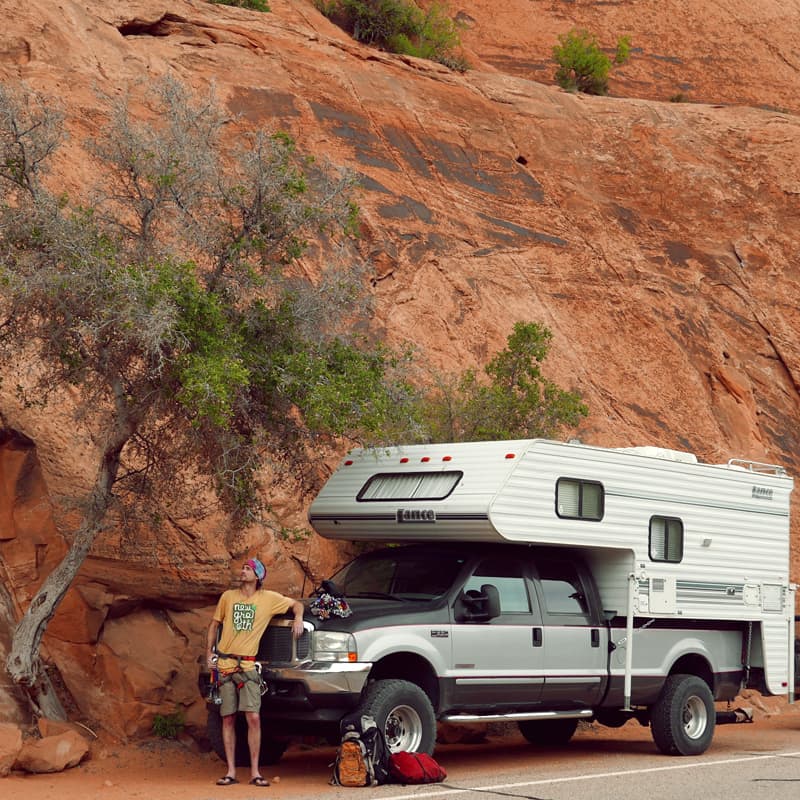
Above: Once you have the gear, climbing is a cheap hobby
TCM: What is a dirtbag climber?
Scott: A dirtbag is someone who lives out of their car, barely getting by, but still managing to travel and rock climb. The true dirtbag lifestyle is mostly lost these days, as almost everyone seems to have fancy vans or campers. We can’t be considered dirtbags because our camper is far too luxurious, but our lifestyle has the same goal.
Johanna: We’re not climbing to beat records or get noticed. A lot of people who live on the road climb a lot. Climbing takes you to places off the beaten path and it’s a different way to see the country.
Scott: There are climbing guide books. Before our trip I bought a bunch and planned between each location. Also, as we’ve been on the road, we’ve gotten into the climbing community. We talk to fellow climbers and they point us in certain directions.
We are starting to recognize and run into people in different locations. Last week we ran into Large Marge the camper. It’s such a small tight nit group of travelers, and a neat community to be a part of.
If you want a cheap hobby, climbing is great. There are hardly any places you have to pay to climb. You don’t have to buy materials once you have them. Many times we have even camped right below the cliff faces.
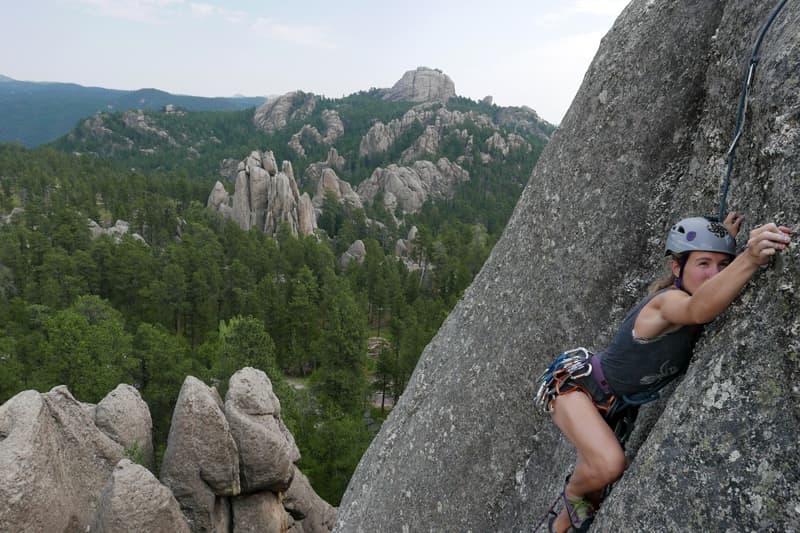
Above: Rock Climbing in the Black Hills, South Dakota
Johanna: We did that in Bishop, California, and in Utah at a lot of places.
Scott: In the western states we stayed in the national forests a lot and they have a fourteen day limit of free camping. The climbing community has petitioned for climbers to boondock at climbing locations without being hassled.
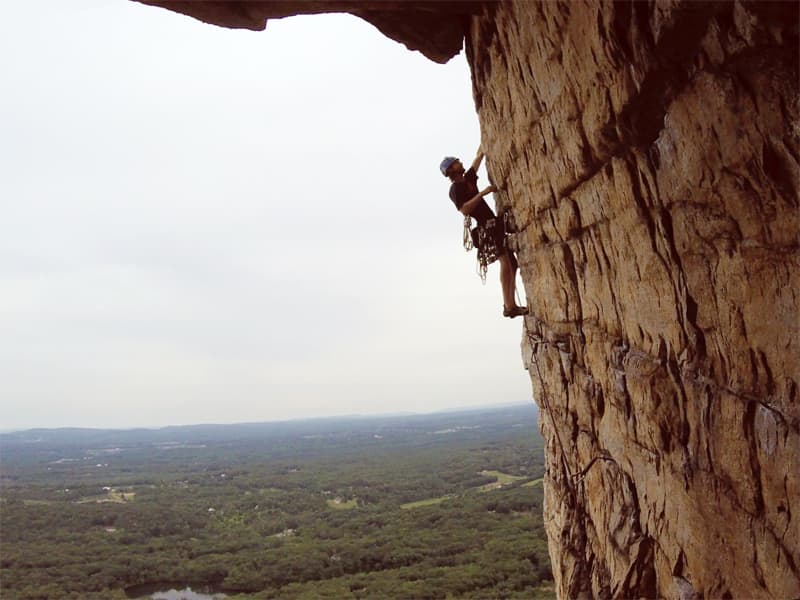
TCM: You’ve got some incredible pictures of you both climbing, but they seem to be from very far off the ground. How do you safely take pictures from that high up?
Scott: We have missed all the best photo opportunities because we were concentrating on holding the ropes. We would have more photos if it was easy to do. The ones we have taken, we have tied off or locked off so we can be hands free. If we were to fall, our gear would catch us.
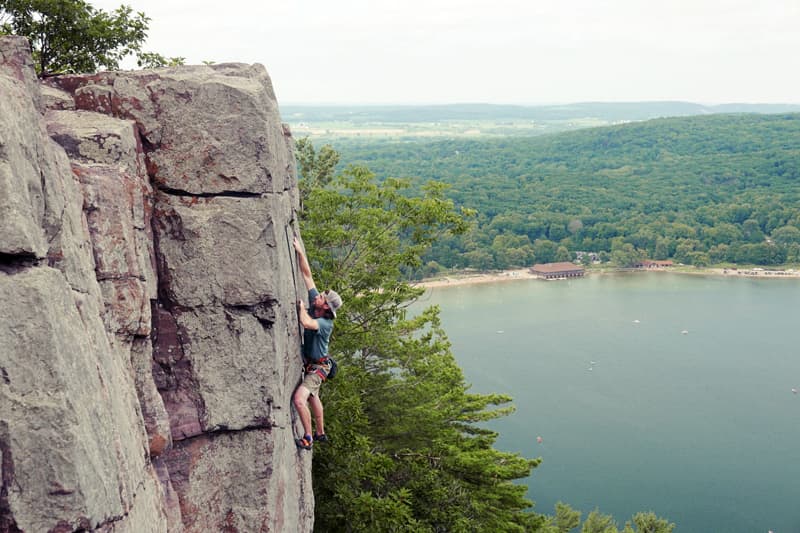
Above: Devils Lake, Wisconsin
Johanna: We have gotten more comfortable as we go. For me, I still worry about multitasking that high off the ground. But if we don’t take the pictures no one else will.
Scott: I have a GoPro, but mainly use a point and shoot Lumix LX100, which is a good medium-sized camera. We looked into a bigger camera with exchangeable lenses, but it would have been too bulky to take climbing.
TCM: The picture quality you get is impressive. Where did the name Rock Resolution come from?
Scott: It was our 2017 New Year’s Resolution; to rock climb outdoors as much as possible.
Johanna: We quit our jobs in February, stayed at Scott’s parent’s house preparing for the trip in March, and then hit the road.
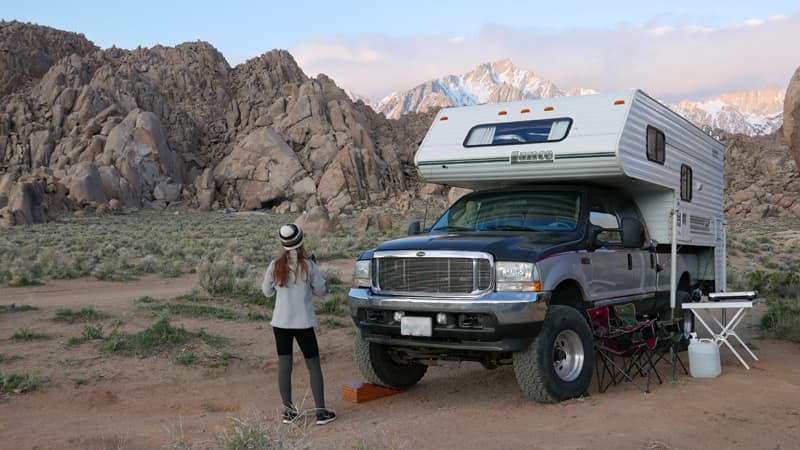
Above: Boondocking in Alabama Hills, California
TCM: Now that you’ve been on the road for a few months, have you been anywhere that you would recommend to fellow truck campers?
Scott: We have covered a lot of ground in our truck camper, and have gone to many off the beaten path places, so the list is endless. There have been a few places that have stood out as truly unique and well worth a return trip.
In Alabama Hills, California you can boondock among granite spires in a high desert setting with views on Mount Whitney. Southern Utah has endless boondocking options in remote sandstone canyons. Escalante Canyon, Colorado has boondocking opportunities in a remote Utah-style deep sandstone canyon along Escalante Creek.
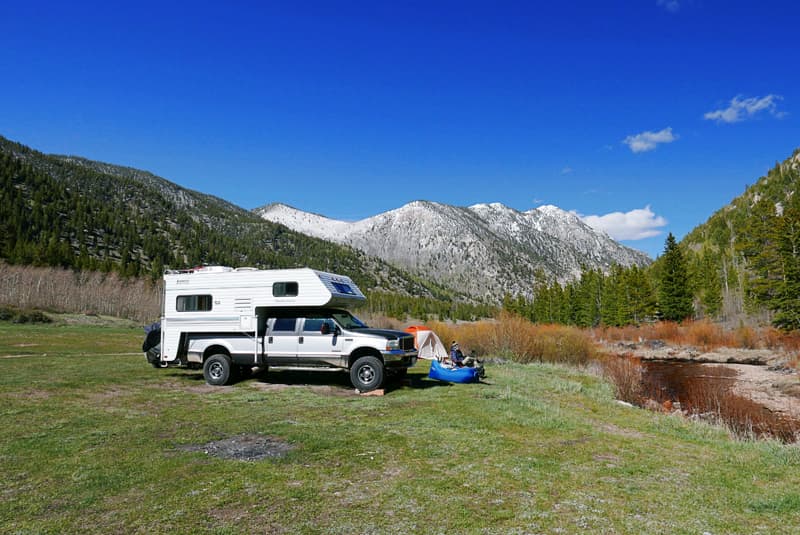
Above: Cottonwood Lake, Buena Vista, Colorado boondocking
We also liked Cottonwood Lake in Buena Vista, Colorado because of the boondocking spots in a pristine creekside meadow at 9,000 feet in elevation. We were between two of Colorado’s fourteeners – mountains over 14,000 feet. We could talk for hours about all the amazing remote places our truck camper has taken us.
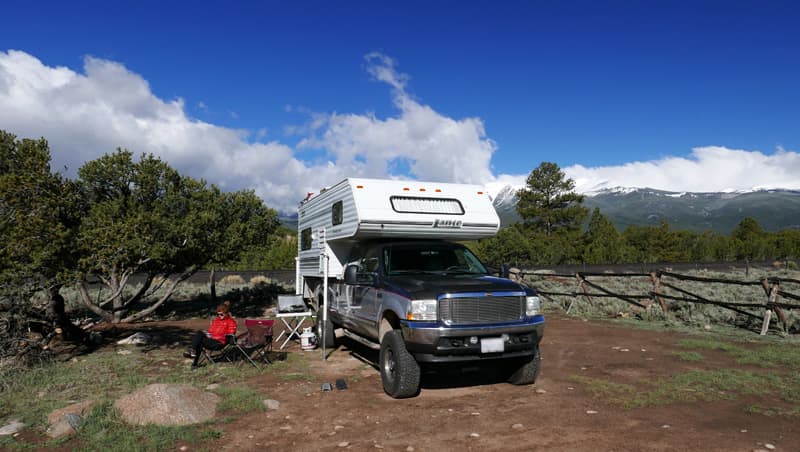
Above: Boondocking in Buena Vista, Colorado
TCM: What do your friends and family think about your current lifestyle on the road?
Johanna: That hasn’t been difficult. My sister, who is fifteen years older than I am, has always lived a crazy lifestyle as a sailor. In 2010 she started her own company with her husband, doing expeditions, research, and diving. They live on a boat and travel the world with their two kids and their dog.
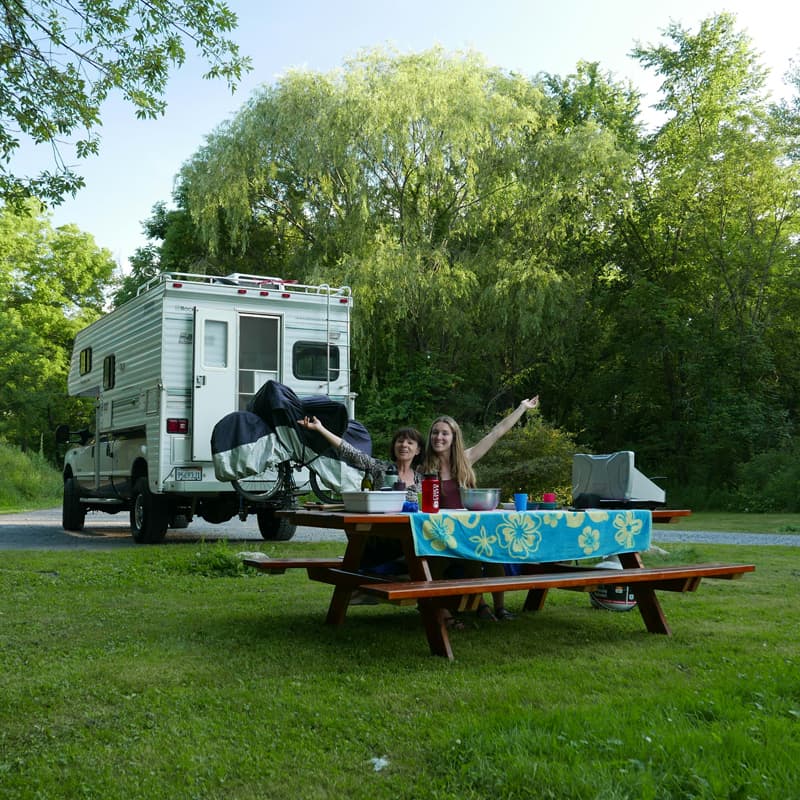
Above: Johanna’s Mom traveled with them for part of their trip, New Paltz, New York
I feel like it’s easy for me to have a lifestyle that’s different. My grandparents think it’s great. My mom is very supportive and she herself wants to travel. She lived on the road back in the 70s; she was a true hippy. She actually stayed with us on our trip for three weeks while we were on the east coast. She’s super chill and loves it! The rest of my family wishes they could visit and do the same, but it’s a little far.
Scott: The general consensus is jealousy. I don’t think a single person has spoken negatively about our lifestyle. Most everyone wishes they could be doing the same, and we are trying to convince them they can.
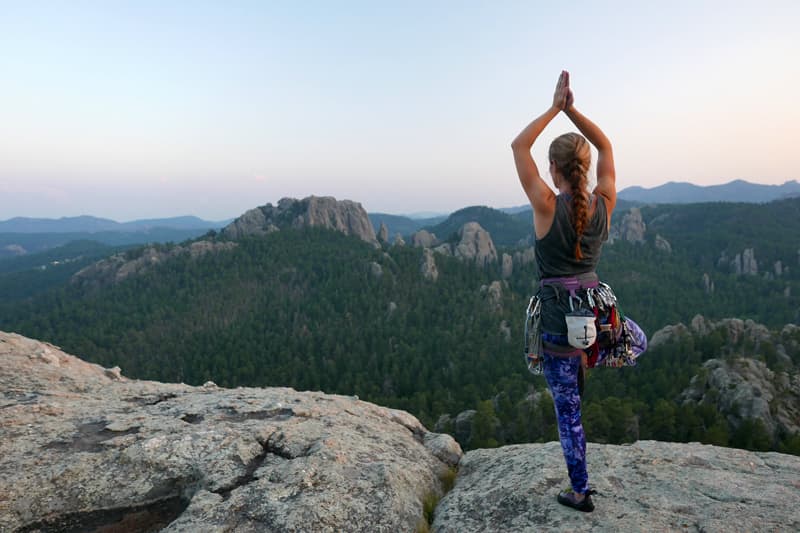
TCM: What are your truck camping plans for the future?
Johanna: This year’s adventure has taken us all the way from the west coast to the east coast. Currently we are in Wyoming and will follow the Rockies north through Montana, Canada, and Alaska. Our return will be to Lake Tahoe, California. Our future plans are to ship the truck camper to Europe for our next full-time adventure.
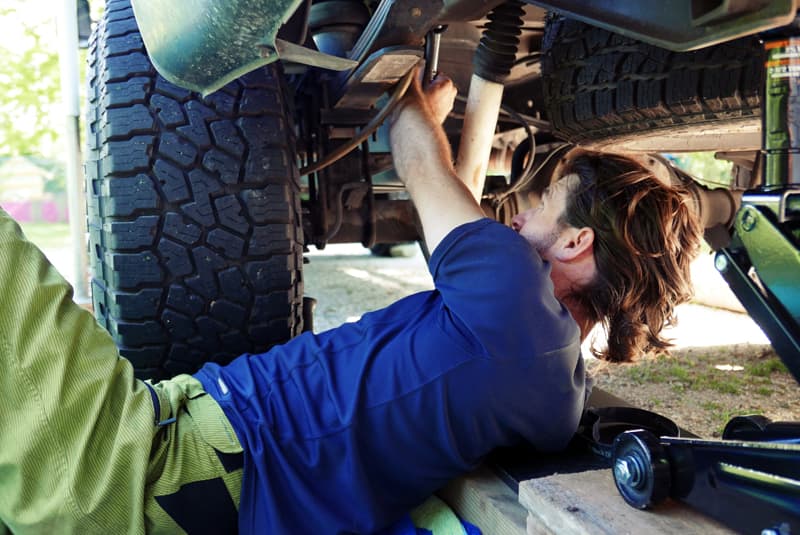
TCM: Now that’s a plan. We’ll have to follow up with you after you’ve explored Europe to see how that adventure goes. Is there anything else that you’d like to share?
Scott: No one really talks about the maintenance of living on the road. Stuff breaks. Having good mechanical knowledge, a good box of tools, and some creativity will get you out of some sticky situations.
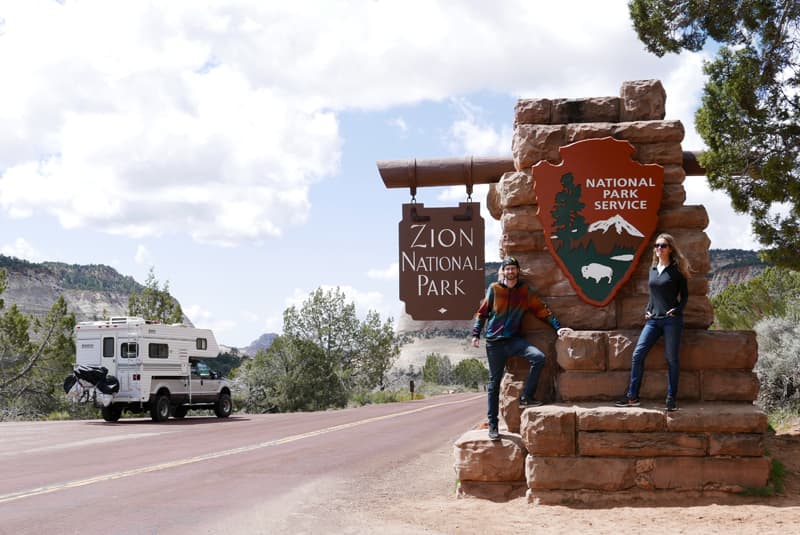
We are both hooked on this lifestyle. It changes how you look at working. Now we think about how we can get money to travel and live in our camper. Our career goals have changed.
I think most people don’t realize how easy and inexpensive it is to enjoy living on the road. Our goal is to convince people that they too can live their dream of traveling. We’d love for you to follow our travels on Instagram!
Scott and Johanna’s Rig
Truck: 2003 Ford F350 7.3L Powerstroke diesel, crew cab, 4×4, single rear wheel, long bed
Camper: 2000 Lance Lite 915
Tie-Downs and Turnbuckles: Generic
Suspension: In the front, dual shocks and rear, Firestone air springs
Gear: Bike rack with homemade hitch extension and step. Home-made hang-board to mount on ladder (for exercise).











